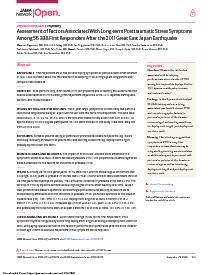Assessment of Factors Associated With Long-term Posttraumatic Stress Symptoms Among 56 388 First Responders After the 2011 Great East Japan Earthquake
Importance: First responders are at risk for developing symptoms of posttraumatic stress disorder (PTSD). Little is known about the risk factors for developing PTSD during a years-long period after complex mass disasters.
Objective: To explore the long-term course of PTSD symptoms and to identify risk factors and their relative association with PTSD among first responders dispatched to the 2011 Japanese earthquake, tsunami, and nuclear disaster.
Design, Setting, and Participants: This 6-year, large, prospective cohort study was part of a continuous longitudinal study of Japan Ground Self-Defense Force first responders. The data were collected at 1, 6, 12, 24, 36, 48, 60, and 72 months after mission completion from 2011 to 2017. Of approximately 70 000 eligible participants, 56 388 were enrolled in this study. Data were analyzed from 2017 to 2020.
Exposures: Stress exposures owing to personal or professional disaster experience (eg, duties with body recovery or radiation exposure risk) and working conditions (eg, deployment length, postdeployment overtime work).
Main Outcomes and Measures: The Impact of Event Scale–Revised score assessed PTSD symptoms; scores of at least 25 were defined as probable PTSD. Cox proportional hazards regression models assessed the risk factors for incidence of probable PTSD.
Results: Among the 56 388 participants, 97.1% were men, and the median age at enrollment was 34 (range, 18-63) years. A probable PTSD rate was 2.7% at 1 month and showed a downward trend in the first year and a subsequent plateau. The cumulative incidence of probable PTSD was 6.75%. The severity of PTSD symptoms demonstrated a high degree of rank-order stability over time. Rather than professional disaster experience, sociodemographic factors and working conditions were independently associated with the incidence of probable PTSD: personal experience of the disaster (hazard ratio [HR], 1.96; 95% CI, 1.72-2.24), deployment length of at least 3 months (HR vs <1 month, 1.75; 95% CI, 1.52-2.02), increased age (HR for ≥46 vs ≤25 years, 2.28; 95% CI, 1.79-2.92), and postdeployment overtime work of at least 3 months (HR vs little to none, 1.61; 95% CI, 1.39-1.87).
Conclusions and Relevance: Given these findings, in the future, first responders’ PTSD symptoms might be mitigated by shortening deployment length, avoiding postdeployment overtime work, and paying special attention to the needs of personnel with personal experience of the disaster or older age. Efforts to alleviate responders’ initial symptoms will be required.
Key Points
Question: What are the risk factors associated with developing posttraumatic stress disorder (PTSD) among first responders deployed to the 2011 Japanese earthquake, tsunami, and nuclear disaster?
Findings: In this 6-year cohort study of 56 388 first responders, a strong association was found between PTSD and sociodemographic factors (ie, personal experience of the disaster, increased age) and working conditions (ie, deployment length, postdeployment overtime work).
Meaning: These findings suggest that symptoms of PTSD among first responders in mass disasters may be mitigated by providing accommodation or additional support to personnel with personal experience of the disaster or increased age as well as monitoring deployment length and postdeployment overtime work.
In: JAMA Network Open ; ISSN: 2574-3805 | 3 | 9 | e2018339
https://jamanetwork.com/journals/jamanetworkopen/fullarticle/2770982


